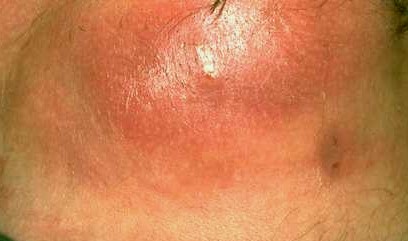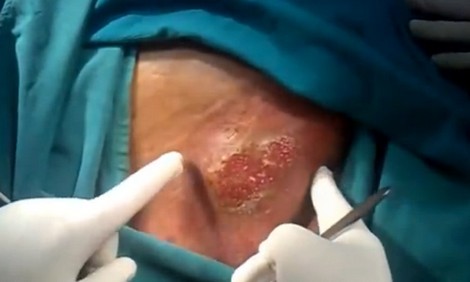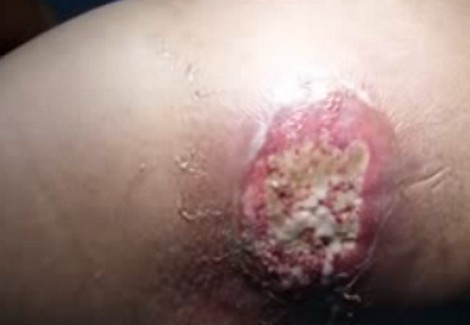Carbuncle is a term used to refer to a group of boils that develop on the skin and often cause pain.
Infection of the hair follicles by bacteria and subsequent inflammation causes the formation of tender reddish bumps on the skin’s surface. These bumps, known as boils or furuncles, rapidly fill with pus and keep getting bigger and severely painful, till they finally rupture and ooze fluids and pus. A group of such interconnected boils occurring beneath an infected section of the skin is referred to as a carbuncle.
A solitary boil or carbuncle can be treated with home remedies. It is important to never squeeze or pop a boil as it can result in spread of the bacterial infection. If an underlying case of carbuncle is accompanied by fever and intense pain for more than 2 weeks, then patients need to seek medical attention.
Symptoms of carbuncle
As boils are a part of a carbuncle, it is important to understand the symptoms of both boils and carbuncles.
Boils can affect any area of the body. They are however more prone to develop on the face, neck, armpits, buttocks, and thighs. These sections of the body have dense hair growth; they are also more prone to friction and perspiration.
Some of the common signs and symptoms of boils are listed below:
- Boils tend to form on the skin as reddish painful lumps. The neighboring skin areas may exhibit inflammation and redness.
- The insides of a boil will slowly fill with pus, which makes it grow bigger in size. Boils can sometimes grow to be as big as a pea or even as large as a golf ball.
- The top part of the boil will later develop a white-yellowish crust in the middle and eventually it will rupture and discharge pus.Once the pus has completely oozed out from the boil, the pain will gradually diminish.
- Small boils tend to heal on their own without scarring. Large boils however leave scar marks after healing.
Carbuncles typically develop on the shoulders, neck, and thighs. It is accompanied by the below listed signs and symptoms:
- Carbuncles cause deeper infections and are more severe as compared to a solitary boil.
- Affected individuals may suffer from uneasiness or nausea, and/or malaise or generalized lethargy or weakness.
- Patients may also elicit fever along with chills.
- Carbuncles can cause extensive scarring.
Complications of carbuncle
Carbuncles normally do not result in any medical complications. However, in rare cases when complications do occur, they tend to be very serious in nature.
- The bacterial infection associated with carbuncles can pass into the blood and from there migrate to varied regions of the body. Such spread of bacterial infection can eventually cause life-threatening sepsis or extensive blood poisoning.Sepsis affects the functioning of important organs like the heart or the bones and damages them. Affected people may suffer from high fever, shortness of breath, and a rapid heart rate, etc. They may also experience a rapid and sudden lowering of the blood pressure leading to septic shock and eventual death.
- Carbuncles can facilitate the growth of certain strains of antibiotic-resistant bacteria.It may be noted that nearly 50 percent of bacteria occurring in hospitals and health care institutions are resistant to different kinds of common antibiotics. Drug resistant bacteria are known to occur in even normal community settings.
Causes
- Carbuncles develop when one or more hair follicles get infected by staph bacteria. The pathogen usually occurs in the nasal passageway, the throat, and the skin.
- The immune system reacts to the presence of an infection and rushes WBCs to the affected area to fight the infection. This is the cause of inflammation, redness, and pus formation.
- The presence of cuts, tears, breaks, scratches, or wounds on the skin increases the risk of infection. Subsequent infection may eventually trigger the formation of a carbuncle.
People of all age groups, races, and genders, including healthy individuals, can develop a carbuncle. However, the below listed risk factors can pose increased threat to development of a carbuncle.
- Close personal contact with an individual infected by staph bacteria.
- Presence of a compromised immune system, as in the case of HIV/AIDS patients, can increase the risk.
- People with acne, eczema, and other skin conditions may suffer from damage of the upper layers of the skin. Such skin is more prone to developing a carbuncle.
- The defense system of a diabetes patient is also weak; hence diabetics are at increased risk.
Treatment of a carbuncle
- Home remedies are sufficient to treat minor boils.
- Warm compresses can hasten the process of automatic pus removal as well as help find relief from pain.
- A carbuncle or large boils need to be medically treated.
- A doctor will perform a minor surgery to manually remove pus and fluids from the carbuncle. It offers rapid easing of pain, quick recovery, and minor or nil scar marks. The surgery can be performed in a doctor’s office.
- Antibiotics are also given to treat and prevent any new infection.
Carbuncle pictures



